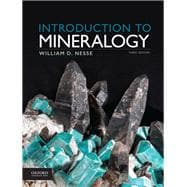Introduction to Mineralogy, Third Edition, consolidates much of the material now covered in traditional mineralogy and optical mineralogy courses and focuses on describing minerals within their geologic context. Presenting the important traditional content of mineralogy--including crystallography, chemical bonding, controls on mineral structure, mineral stability, and crystal growth--it provides students with a foundation for understanding the nature and occurrence of minerals.
FEATURES
Describes in detail physical, optical, and X-ray powder diffraction techniques of mineral study
Outlines common chemical analytical methods
Provides thorough descriptions of more than 100 common minerals, emphasizing the geologic contexts within which they occur
Includes tables and diagrams that help students identify minerals using both physical and optical properties
Incorporates numerous line drawings, photographs, and photomicrographs that elucidate complex concepts
Introduction to Mineralogy can be packaged with Daniel Schulze's An Atlas of Minerals in Thin Section for use in your course for a nominal additional fee.








